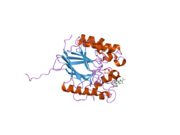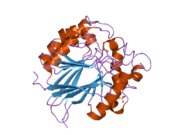Tartrate-resistant acid phosphatase
Ensembl |
| ||||||||
|---|---|---|---|---|---|---|---|---|---|
| UniProt |
| ||||||||
| RefSeq (mRNA) |
| ||||||||
| RefSeq (protein) |
| ||||||||
| Location (UCSC) | Chr 19: 11.57 – 11.58 Mb | n/a | |||||||
| PubMed search | [2] | n/a | |||||||
| View/Edit Human | |||
Tartrate-resistant acid phosphatase (TRAP or TRAPase), also called acid phosphatase 5, tartrate resistant (ACP5), is a
The mechanism of phosphate ester hydrolysis by TRAP is through a nucleophilic attack mechanism,[6] whereby, catalysis occurs with the binding of a phosphate-substrate to the Fe2+ in the active site of TRAP. This is then followed by a nucleophilic attack by a hydroxide ligand on the bound phosphorus atom, resulting in cleavage of the phosphate ester bond and production of an alcohol. The exact identity and mechanism of the hydroxide ligand is unclear, but it is thought to be either a hydroxide that bridges the metal ions within the active site or a terminal hydroxide bound to Fe3+, with conflicting reports for both mechanisms.
TRAP expression and cell localization
Under normal circumstances, TRAP is highly expressed by
In osteoclasts, TRAP is localized within the ruffled border area, the lysosomes, the Golgi cisternae and vesicles.[5]
TRAP gene, promoter organisation and transcription
Mammalian TRAP is encoded by one gene, which is localized on chromosome 19 (19p13.2–13.3) in humans, and on chromosome 9 in mice. TRAP DNA is, as expected from protein sequencing, highly conserved throughout the class mammalia. The TRAP gene has been cloned and sequenced in porcine, rat, human, and murine species.[9] Human, murine, and porcine TRAP genes all contain 5 exons, and have the ATG codon at the beginning of exon 2, with exon 1 being non-coding. Within the exon 1 promoter, there are three distinct “tissue-specific”
Physiology and pathology
Many functions have been attributed to TRAP, and its physiologic role(s) are likely to be manifold. The mice knockout studies as well as the human disorder associated with genetic deficiency of TRAP shed some light onto its functions. In knockout studies, TRAP−/− mice exhibit mild osteopetrosis, associated with reduced osteoclast activity. These result in thickening and shortening of the cortices, formation of club-like deformities in the distal femur, and widened epiphyseal growth plates with delayed mineralization of cartilage, all of which increase with age.[13] In TRAP overexpressing transgenic mice, mild osteoporosis occurs along with increased osteoblast activity and bone synthesis.[14] Proposed functions of TRAP include
Protein dephosphorylation and osteoclast migration
It has been shown that osteopontin and bone sialoprotein, bone matrix phosphoproteins, are highly efficient in vitro TRAP
ROS generation
Reactive oxygen species (ROS) are generated in macrophages and osteoclasts from superoxide (O2−.), which forms from the action of NADPH-oxidase on oxygen (O2).[18] They play an essential role in the function of phagocytic cells.
TRAP, containing a redox active iron, catalyzes the generation of ROS through Fenton chemistry:[19]
- O2 → (NADPH-oxidase) O2− ∙ → (superoxide dismutase) H2O2 → (catalase) H2O + O2
- TRAP-Fe3+ (purple) + O2− ∙→ TRAP-Fe2+ (pink) + O2
- H2O2 + TRAP-Fe2+ (pink) → HO∙ + HO− + TRAP-Fe3+
producing
Iron transport
In the pregnant sow, uteroferrin is highly expressed in the uterine fluids.[20] Due to the unique anatomy of the porcine uterus, and the specific, progesterone-induced expression of TRAP; it is hypothesized that uteroferrin acts as an iron transport protein.
Cell growth and differentiation factor
TRAP is associated with osteoclast migration to bone resorption sites, and, once there, TRAP is believed to initiate osteoclast differentiation, activation, and proliferation. This hypothesis was formed from the examination of the bone structure of TRAP-null mice. It was noted that, in addition to osteopetrosis, bone formation occurred in a haphazard manner, where the microarchitecture was highly irregular.[21]
In TRAP overexpressing mice, it has been found that the affected mice are grossly obese. This has led to the hypothesis that TRAP has involvement in hyperplastic obesity.
References
- ^ a b c GRCh38: Ensembl release 89: ENSG00000102575 – Ensembl, May 2017
- ^ "Human PubMed Reference:". National Center for Biotechnology Information, U.S. National Library of Medicine.
- S2CID 30416983.
- PMID 10493912.
- ^ PMID 15929988.
- PMID 8683579.
- PMID 13664936.
- S2CID 22706943.
- PMID 8359686.
- PMID 12706893.
- S2CID 24064612.
- S2CID 24698373.
- PMID 8898228.
- S2CID 35584934.
- ^ "Spondyloenchondrodysplasia With Immune Dysregulation; Spencdi". OMIM.
- S2CID 205357235.
- PMID 8195113.
- S2CID 32443917.
- .
- PMID 3527760.
- PMID 12403789.
External links
- tartrate-resistant+acid+phosphatase at the U.S. National Library of Medicine Medical Subject Headings (MeSH)


